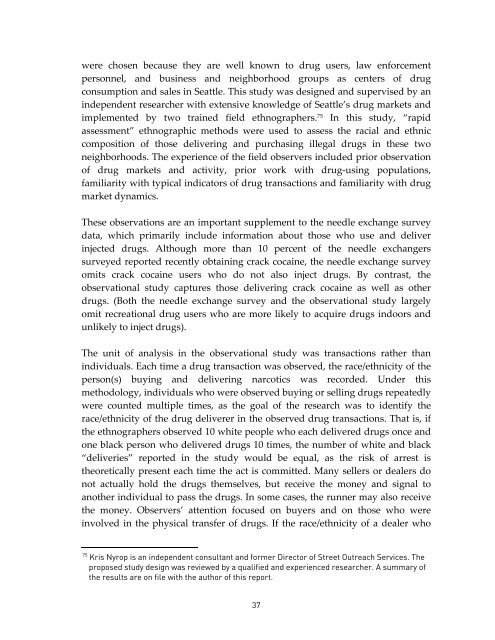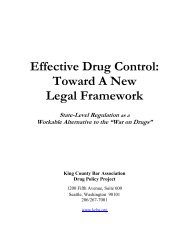RACE AND THE ENFORCEMENT OF DRUG DELIVERY LAWS IN ...
RACE AND THE ENFORCEMENT OF DRUG DELIVERY LAWS IN ...
RACE AND THE ENFORCEMENT OF DRUG DELIVERY LAWS IN ...
Create successful ePaper yourself
Turn your PDF publications into a flip-book with our unique Google optimized e-Paper software.
were chosen because they are well known to drug users, law enforcement<br />
personnel, and business and neighborhood groups as centers of drug<br />
consumption and sales in Seattle. This study was designed and supervised by an<br />
independent researcher with extensive knowledge of Seattle’s drug markets and<br />
implemented by two trained field ethnographers. 75 In this study, “rapid<br />
assessment” ethnographic methods were used to assess the racial and ethnic<br />
composition of those delivering and purchasing illegal drugs in these two<br />
neighborhoods. The experience of the field observers included prior observation<br />
of drug markets and activity, prior work with drug-using populations,<br />
familiarity with typical indicators of drug transactions and familiarity with drug<br />
market dynamics.<br />
These observations are an important supplement to the needle exchange survey<br />
data, which primarily include information about those who use and deliver<br />
injected drugs. Although more than 10 percent of the needle exchangers<br />
surveyed reported recently obtaining crack cocaine, the needle exchange survey<br />
omits crack cocaine users who do not also inject drugs. By contrast, the<br />
observational study captures those delivering crack cocaine as well as other<br />
drugs. (Both the needle exchange survey and the observational study largely<br />
omit recreational drug users who are more likely to acquire drugs indoors and<br />
unlikely to inject drugs).<br />
The unit of analysis in the observational study was transactions rather than<br />
individuals. Each time a drug transaction was observed, the race/ethnicity of the<br />
person(s) buying and delivering narcotics was recorded. Under this<br />
methodology, individuals who were observed buying or selling drugs repeatedly<br />
were counted multiple times, as the goal of the research was to identify the<br />
race/ethnicity of the drug deliverer in the observed drug transactions. That is, if<br />
the ethnographers observed 10 white people who each delivered drugs once and<br />
one black person who delivered drugs 10 times, the number of white and black<br />
“deliveries” reported in the study would be equal, as the risk of arrest is<br />
theoretically present each time the act is committed. Many sellers or dealers do<br />
not actually hold the drugs themselves, but receive the money and signal to<br />
another individual to pass the drugs. In some cases, the runner may also receive<br />
the money. Observers’ attention focused on buyers and on those who were<br />
involved in the physical transfer of drugs. If the race/ethnicity of a dealer who<br />
75<br />
Kris Nyrop is an independent consultant and former Director of Street Outreach Services. The<br />
proposed study design was reviewed by a qualified and experienced researcher. A summary of<br />
the results are on file with the author of this report.<br />
37

















